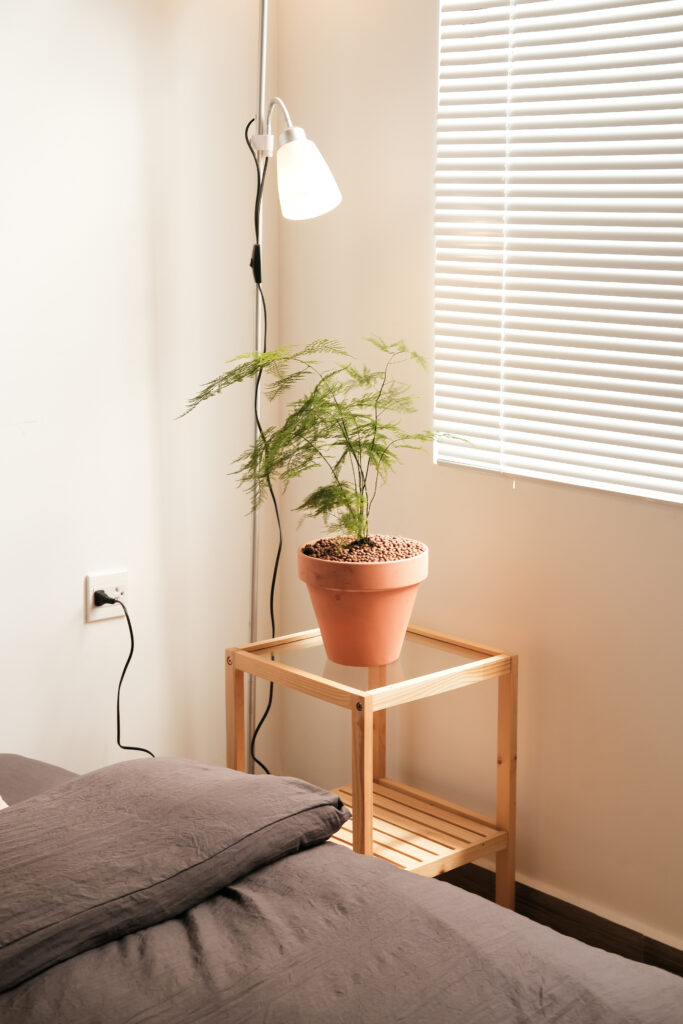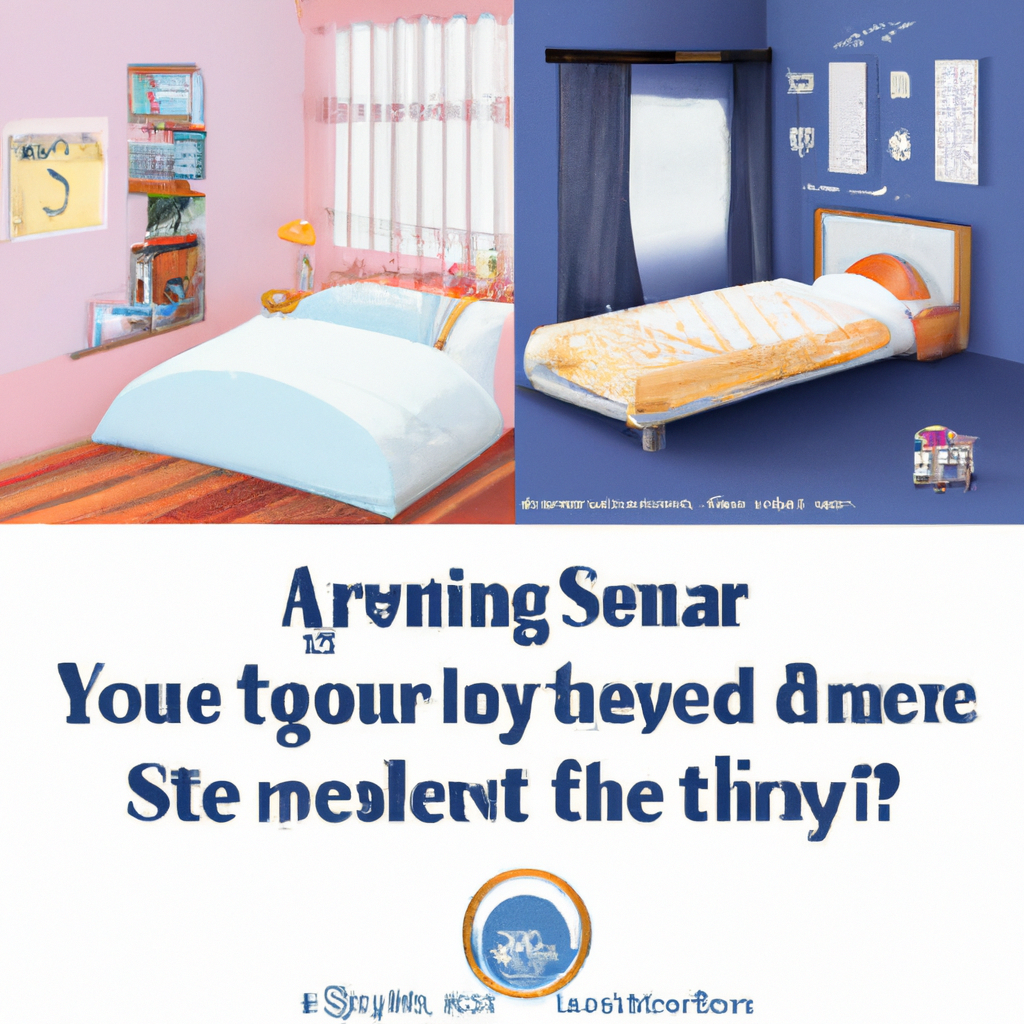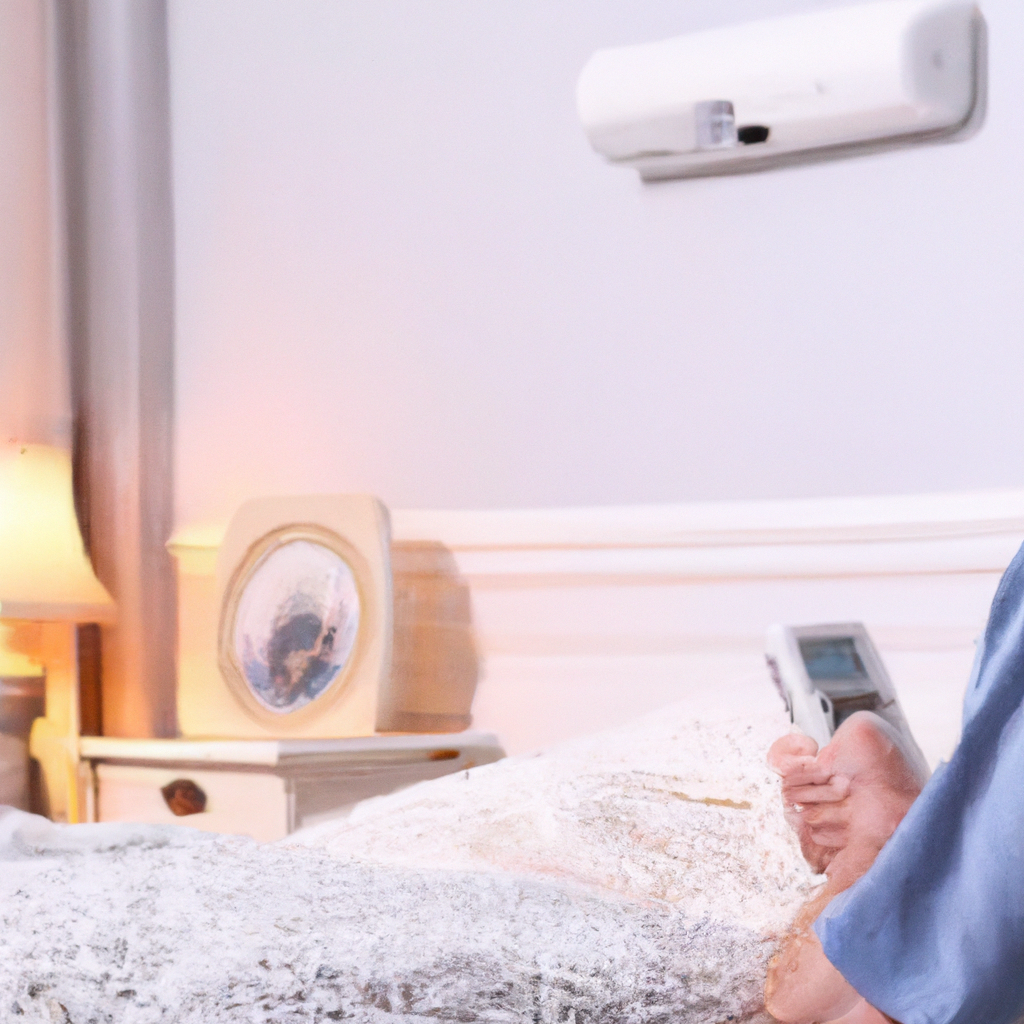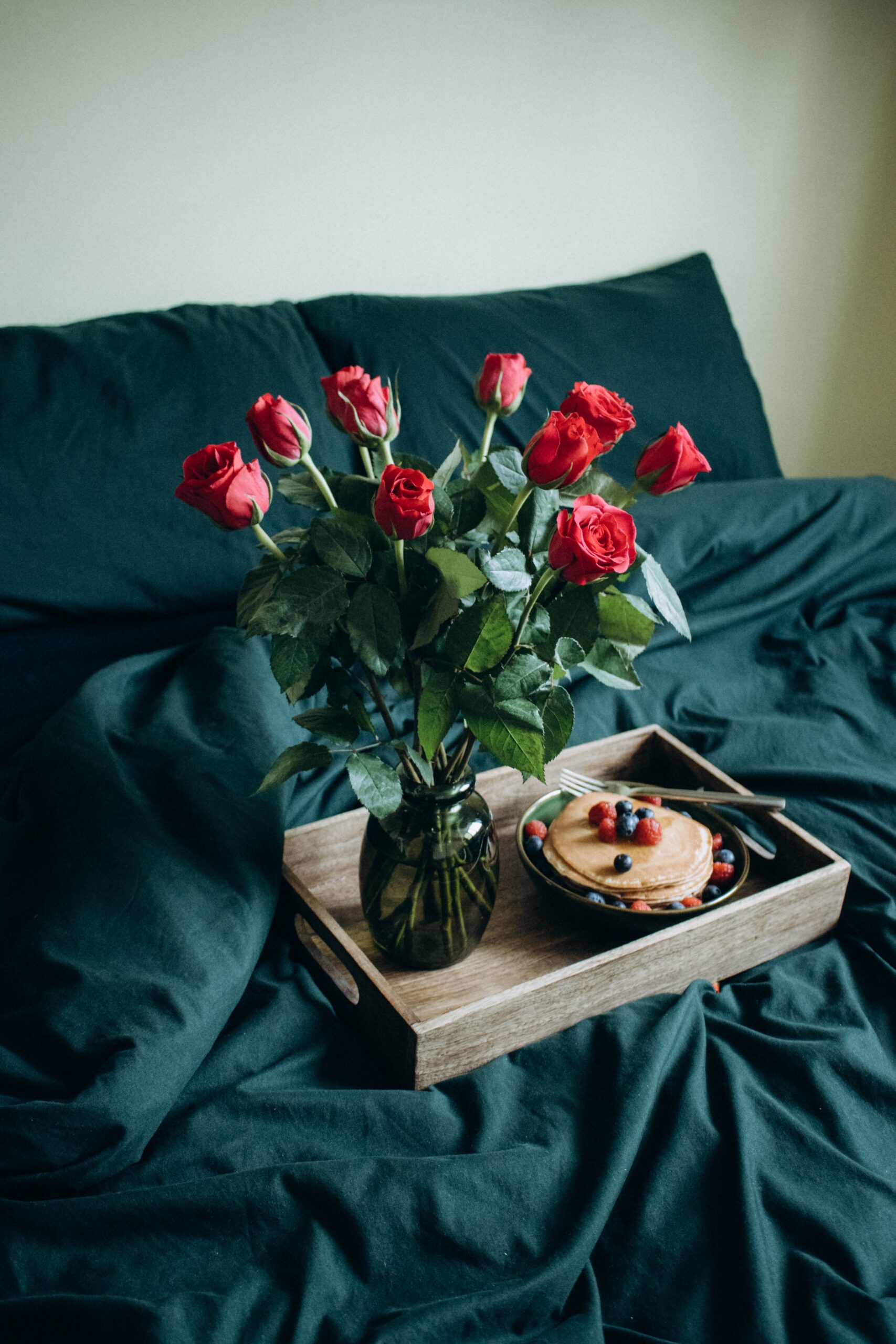Imagine being able to provide your loved ones with a safe and healthy bedroom that constantly monitors their well-being. With smart monitoring technology, it is now possible to create a space specifically designed for senior citizens, offering peace of mind and extra care. From tracking sleep patterns to detecting falls, this innovative approach ensures the safety and health of your seniors in an unobtrusive and reliable manner. Let’s explore how you can transform a regular bedroom into a smart sanctuary for your elderly family members.

Creating a Safe and Healthy Bedroom for Senior Citizens with Smart Monitoring
As we age, it becomes increasingly important to pay attention to our living environment and make necessary adjustments to ensure safety and promote good health. One area that deserves special attention is the bedroom, where we spend a significant amount of time resting and rejuvenating. By incorporating smart monitoring systems, we can create a safe and healthy bedroom for senior citizens, offering peace of mind for both seniors and their caregivers.
Importance of a Safe and Healthy Bedroom for Seniors
The bedroom serves as a sanctuary for rest and relaxation, and for seniors, it becomes even more vital to create a safe and healthy environment. As we age, our vulnerability to accidents and health issues increases, making it crucial to minimize risks and optimize conditions for a good night’s sleep. A safe and healthy bedroom can significantly improve the quality of life for seniors, reducing the likelihood of falls, promoting better sleep, and providing peace of mind for both seniors and their loved ones.
Benefits of Smart Monitoring in Senior Bedrooms
Integrating smart monitoring systems into senior bedrooms can revolutionize how we care for older adults. These innovative technologies provide real-time insights into sleep patterns, movement, and vital signs, allowing caregivers to promptly address any concerns and provide immediate assistance if needed. Additionally, smart monitoring systems can detect and alert caregivers to potential risks, such as falls, ensuring timely interventions and minimizing the severity of injuries. By using smart monitoring in senior bedrooms, we can enhance the safety, health, and overall well-being of our beloved seniors.
Choosing Appropriate Bedding and Furniture
Selecting the right bedding and furniture is the foundation of creating a safe and comfortable environment for seniors in their bedrooms. Here are some key considerations:
Selecting a Comfortable and Supportive Mattress
Choosing a mattress that provides optimal comfort and support is crucial for seniors. Look for a mattress that offers appropriate firmness and helps alleviate pressure points to reduce the risk of developing bedsores. Memory foam or hybrid mattresses can be excellent choices, as they contour to the body and provide even support. Consider factors such as individual preferences, medical conditions, and any specific requirements, such as adjustable firmness or temperature control.
Using Bed Rails for Added Safety
Bed rails can provide seniors with added safety and support, especially those at risk of falling out of bed during sleep or while getting in and out. High-quality bed rails should be sturdy, easy to install, and adjustable to fit different bed sizes. It is essential to ensure that bed rails are properly secured and regularly inspected to avoid accidents or injuries.
Opting for Adjustable Beds
For seniors who experience difficulties with mobility or have specific medical conditions, adjustable beds can offer immense comfort and convenience. These beds allow users to adjust the head and foot positions, making it easier to find the perfect sleeping or resting position. Adjustable beds can alleviate back pain, improve circulation, and help with conditions such as acid reflux or sleep apnea.
Considering Senior-friendly Furniture
When choosing furniture for senior bedrooms, opt for pieces that prioritize safety and ease of use. Look for dressers, nightstands, and chairs with sturdy construction and rounded edges to minimize the risk of accidental injuries. Additionally, consider furniture with ample storage space to keep the bedroom clutter-free, reducing trip and fall hazards. Furniture should be at an appropriate height, making it easy for seniors to sit and stand without straining their joints or muscles.

Ensuring Adequate Lighting
Proper lighting in a senior’s bedroom is essential for safety and comfort, especially during nighttime. Consider the following measures to ensure adequate lighting:
Installing Motion-Activated Night Lights
Motion-activated night lights are a practical and energy-efficient solution to illuminate the path when moving around the bedroom at night. These lights automatically turn on when motion is detected, providing just the right amount of illumination without disturbing sleep. Place them strategically in areas such as hallways, near the bed, or in the bathroom to guide seniors safely and avoid accidents.
Using Smart Bulbs and Dimmers
Smart bulbs and dimmers offer the flexibility to adjust the lighting levels according to individual preferences. Seniors can easily control the brightness or warmth of the lights using a smartphone app or voice commands. This feature is particularly useful for those with vision impairment or sensitivity to bright lights. Smart bulbs can also be programmed to gradually dim during bedtime, promoting a more relaxing and restful sleep environment.
Ensuring Proper Placement of Lighting Fixtures
In addition to using motion-activated lights and smart bulbs, it’s crucial to position lighting fixtures thoughtfully. Ensure that light switches are easily accessible from the bed and throughout the room, minimizing the need to navigate in the dark. Consider task lighting, such as bedside lamps or wall-mounted fixtures, for activities such as reading. Aim for even and balanced lighting to eliminate shadows and reduce the risk of trips or falls.
Implementing Fall Prevention Measures
Falls are a leading cause of injury among seniors, and the bedroom is not exempt from potential hazards. Implementing fall prevention measures can significantly reduce the risk of accidents and injuries. Here are several strategies to consider:
Installing Grab Bars near the Bed and Bathroom
Installing grab bars near the bed and in the bathroom can provide seniors with additional stability and support when getting in and out of bed, using the toilet, or taking a shower. These bars should be securely fastened to the wall and designed to bear the weight of an individual if necessary. Textured or non-slip surfaces on the grab bars can further enhance grip and reduce the risk of slipping.
Using Non-slip Flooring and Rugs
Slippery floors and rugs pose significant risks for falls. Opt for flooring materials that provide good traction, such as non-slip vinyl or textured laminate. Remove any loose rugs or use non-slip rug pads to secure them in place. It’s crucial to ensure that floors are dry and free from any spills or debris that could lead to slipping accidents.
Removing Obstacles and Clutter
A cluttered bedroom can make maneuvering difficult, increasing the likelihood of tripping or falling. Keep the bedroom tidy and free from unnecessary clutter, ensuring clear pathways. Secure electrical cords and wires along walls or use cord concealers to prevent tripping hazards. Remove any furniture or objects that may obstruct movement, making it easier for seniors to get around safely.
Securing Loose Cords and Wires
Loose cords and wires not only pose tripping hazards but also increase the risk of electrical accidents. Ensure that all electrical cords and wires are properly secured and safely out of the way. Use cable organizers or cord clips to bundle and hide cords, minimizing the risk of entanglement or accidentally pulling on them.
Using Fall Detection Systems
Fall detection systems are invaluable tools that provide an added layer of safety, particularly for seniors prone to falls. These systems are designed to automatically detect falls and send alerts to caregivers or emergency services. Some fall detection systems are integrated into wearable devices, while others utilize smart monitoring technology. By promptly alerting caregivers or emergency responders, fall detection systems can ensure timely assistance and potentially save lives.

Enhancing Indoor Air Quality
Indoor air quality can significantly impact overall health and well-being, particularly for seniors who may have respiratory conditions or compromised immune systems. Taking measures to enhance indoor air quality in the bedroom can make a substantial difference. Consider the following strategies:
Using Air Purifiers and Filters
Air purifiers and filters can remove airborne particles, allergens, and pollutants, promoting cleaner and healthier air in the bedroom. Look for air purifiers with HEPA (High-Efficiency Particulate Air) filters, as they efficiently capture microscopic particles like dust, pollen, pet dander, and even some bacteria and viruses. Regularly clean or replace the filters as recommended to maintain optimal performance.
Regularly Ventilating the Bedroom
Proper ventilation is essential for removing indoor air pollutants and maintaining a fresh and healthy indoor environment. Open windows whenever possible to allow for natural airflow. If the bedroom does not have adequate ventilation or air circulation, consider installing a ventilation system or utilizing fans to improve air exchange. Ventilation can help reduce humidity, prevent mold growth, and eliminate stagnant air.
Avoiding Allergens and Irritants
Seniors with allergies or respiratory conditions may be sensitive to certain allergens or irritants commonly found in the bedroom. Keep the bedroom free from dust mites by regularly washing bedding in hot water and using allergen-proof covers. Avoid using harsh chemical cleaners or aerosol sprays, as they can release harmful fumes. Opt for fragrance-free and hypoallergenic products when choosing cleaning supplies, detergents, and personal care items.
Maintaining Cleanliness and Proper Hygiene
Maintaining a clean and hygienic bedroom is key to preventing the accumulation of dust, dirt, and allergens. Regularly vacuum the floors, dust surfaces, and clean bedding to minimize the presence of irritants. Pay special attention to areas that are difficult to reach, such as under the bed or behind furniture. Consider using a vacuum cleaner with a HEPA filter to ensure effective removal of particles from the air.
Ensuring Comfortable Temperature and Humidity Levels
Temperature and humidity levels play crucial roles in creating a comfortable and healthy sleep environment. Here are some tips to consider:
Using Smart Thermostats for Temperature Control
Smart thermostats offer convenient and precise control over the temperature in the bedroom, allowing seniors to set their preferred levels without hassle. These thermostats can be easily programmed to adjust the temperature throughout the day, optimizing comfort during sleep and waking hours. Consider features such as scheduling, remote control options, and compatibility with voice-activated assistants for added convenience.
Maintaining Optimal Humidity Levels
Humidity levels in the bedroom can impact comfort and respiratory health. Keep humidity levels between 30% and 50% to prevent dryness or excessive moisture. Using humidifiers or dehumidifiers can help maintain the ideal humidity range, depending on the climate and individual preferences. Regularly clean and maintain these devices according to the manufacturer’s instructions to prevent the growth of bacteria or mold.
Considering Personal Preferences and Medical Conditions
Everyone has different temperature and humidity preferences, and seniors are no exception. It’s essential to take into account individual comfort levels and any specific medical conditions that may affect temperature regulation. Consider factors such as menopausal symptoms, arthritis, or respiratory conditions when setting temperature and humidity levels. Open communication with seniors about their comfort, and regular experimentation with settings can help find the optimal conditions for restful sleep.

Promoting Sleep Quality and Routine
A good night’s sleep is essential for overall health and well-being, and seniors are no exception. Creating a calm and relaxing atmosphere in the bedroom can promote better sleep quality and establish consistent sleep patterns. Consider the following strategies:
Creating a Calm and Relaxing Atmosphere
Design the bedroom with soothing colors, soft textures, and minimal distractions. Choose a color palette that promotes relaxation, such as cool blues or earthy greens. Use calming wall art or decor to create a serene environment. Ensure that the bedroom is free from noise, excessive light, and clutter, allowing seniors to unwind and prepare for sleep.
Using White Noise Machines or Sleep Sounds
White noise machines or sleep sounds can help drown out background noise and provide a consistent and soothing sound environment. These devices emit calming sounds, such as gentle rain, ocean waves, or soft melodies, to promote relaxation and mask any disruptive noises. Seniors can adjust the volume and choose the type of sound that works best for them to induce sleep.
Implementing Sleep Tracking Devices
Sleep tracking devices, such as smartwatches or activity trackers, can provide valuable insights into sleep patterns and help identify any potential issues. These devices monitor parameters like sleep duration, sleep stages, and sleep efficiency. By analyzing the data, seniors and caregivers can gain a better understanding of sleep quality and make informed decisions to improve sleep habits.
Establishing Consistent Sleep Patterns
Consistency is key when it comes to establishing healthy sleep patterns. Help seniors develop a regular sleep routine by encouraging them to go to bed and wake up at the same time every day. Creating a predictable pattern signals the body to prepare for sleep, making it easier to fall asleep and wake up refreshed. Encourage activities such as reading, relaxing, or light stretching before bedtime to unwind and signal the body to transition to sleep.
Integrating Smart Monitoring Systems
Smart monitoring systems are invaluable tools for keeping track of seniors’ well-being and quickly responding to emergencies. By utilizing various smart monitoring technologies, we can enhance the safety, independence, and overall quality of life for seniors. Consider the following options:
Utilizing Bed Sensors for Sleep Monitoring
Bed sensors can detect movement, heart rate, and respiration patterns, providing valuable insights into sleep quality and overall health. These sensors can be placed under the mattress or integrated into the bed frame to monitor sleep patterns and detect any irregularities. Caregivers can access this information remotely and promptly address any concerns regarding sleep quality or potential health issues.
Installing Video or Audio Monitoring Systems
Video or audio monitoring systems can offer real-time visibility and audio communication between seniors and caregivers. These systems, which can be integrated into smartphones or dedicated devices, allow caregivers to remotely check on seniors, ensuring their safety and well-being. Video monitoring systems are particularly useful in detecting any signs of distress, falls, or other emergencies, enabling immediate assistance.
Implementing Vital Sign Tracking Devices
Vital sign tracking devices, such as wearable monitors or wireless sensors, provide continuous monitoring of essential health indicators such as heart rate, blood pressure, or oxygen saturation levels. These devices transmit data in real-time to caregivers or healthcare professionals, enabling proactive interventions and reducing the risk of undetected health issues. Regular monitoring of vital signs can help identify any changes or abnormalities, allowing for timely medical intervention if necessary.
Integrating Voice-Activated Assistance
Voice-activated assistants, such as smart speakers or virtual assistants, offer seniors a convenient and hands-free way to interact with their surroundings. These devices can help with tasks such as setting reminders, controlling smart devices, or accessing information. Voice-activated assistance can also serve as emergency call systems, enabling seniors to call for help or notify caregivers in case of emergencies.
Utilizing Emergency Call Systems
Emergency call systems provide quick access to assistance in case of emergencies. These systems typically consist of wearable devices or wall-mounted buttons that seniors can press to request help. When activated, emergency call systems can notify caregivers, family members, or emergency services, ensuring prompt response and potentially preventing adverse outcomes. Ensure that emergency call systems are easily accessible from various points in the bedroom and familiarize seniors with their usage.

Facilitating Medication Management
Managing medication regimens can be challenging, especially for seniors who take multiple medications or have memory impairments. Smart monitoring can help streamline medication management processes and enhance safety. Consider the following approaches:
Using Smart Pill Dispensers
Smart pill dispensers are equipped with features like medication reminders, alarms, and individual compartments for different doses and times. These devices can help seniors stay organized, ensuring they take the right medications at the prescribed times. Some smart pill dispensers can also send notifications to caregivers if a dose is missed, providing an added layer of accountability and safety.
Setting Reminders and Alerts
Utilize reminders and alerts through smartphones, smartwatches, or voice-activated assistants to help seniors remember to take their medications. These reminders can be programmed to go off at specific times or intervals, ensuring seniors stay on track with their medication schedules. Reminders can also be customized with personalized messages or instructions to further enhance compliance.
Integrating Medication Tracking Apps
Medication tracking apps can help seniors and caregivers keep track of medication schedules, dosage instructions, and refill needs. These apps can send notifications, provide information on potential drug interactions or side effects, and generate reports for healthcare providers. By centralizing medication information in one accessible platform, medication tracking apps can reduce the risk of errors or missed doses.
Ensuring Safety with Medication Storage
Proper medication storage is essential for maintaining medication efficacy and ensuring seniors’ safety. Store medications in a cool, dry place away from direct sunlight, humidity, or extreme temperatures. Keep medications out of reach of children, but in a place easily accessible for seniors. Consider using organizers or pillboxes to pre-sort medications according to the schedule, further minimizing confusion or mistakes.
Maintaining Privacy and Security
While smart monitoring systems offer numerous benefits, it’s crucial to prioritize privacy and security when integrating these technologies into senior bedrooms. Protecting personal data and ensuring the safe use of smart devices are essential considerations. Follow these guidelines for maintaining privacy and security:
Choosing Trusted and Secure Smart Devices
Select smart monitoring devices from reputable manufacturers known for their commitment to privacy and security. Conduct thorough research and read reviews to ensure the devices are reliable and have robust security measures in place. Look for devices with encryption capabilities, regular firmware updates, and clear privacy policies.
Protecting Personal Data
Take steps to protect personal data collected by smart monitoring systems. Secure networks with strong passwords and utilize encryption protocols to safeguard information transmitted between devices. Regularly update software to ensure the latest security patches are applied. Educate seniors and caregivers about the importance of not sharing personal information online or with unauthorized individuals or companies.
Maintaining Secure Wi-Fi Networks
Secure Wi-Fi networks are essential for maintaining privacy and preventing unauthorized access to smart devices. Use strong, unique passwords for Wi-Fi networks and change them regularly. Enable network encryption protocols such as WPA2, and consider using guest networks for visitors to limit their access to sensitive devices or data.
Educating Seniors about Privacy Risks
Educating seniors about privacy risks associated with smart monitoring systems is key to promoting their autonomy and keeping them aware of potential vulnerabilities. Teach seniors to recognize potential privacy threats, such as phishing emails or fake software updates, and how to respond appropriately. Encourage seniors to ask questions about the privacy practices of smart devices and to raise any concerns they may have.
In conclusion, creating a safe and healthy bedroom for senior citizens with smart monitoring systems is an effective way to enhance their overall well-being and provide peace of mind for both seniors and caregivers. By incorporating appropriate bedding and furniture, ensuring adequate lighting, implementing fall prevention measures, enhancing indoor air quality, maintaining comfortable temperature and humidity levels, promoting sleep quality and routine, integrating smart monitoring systems, facilitating medication management, and prioritizing privacy and security, we can optimize the living environment for seniors and support their independent and healthy lifestyle.
